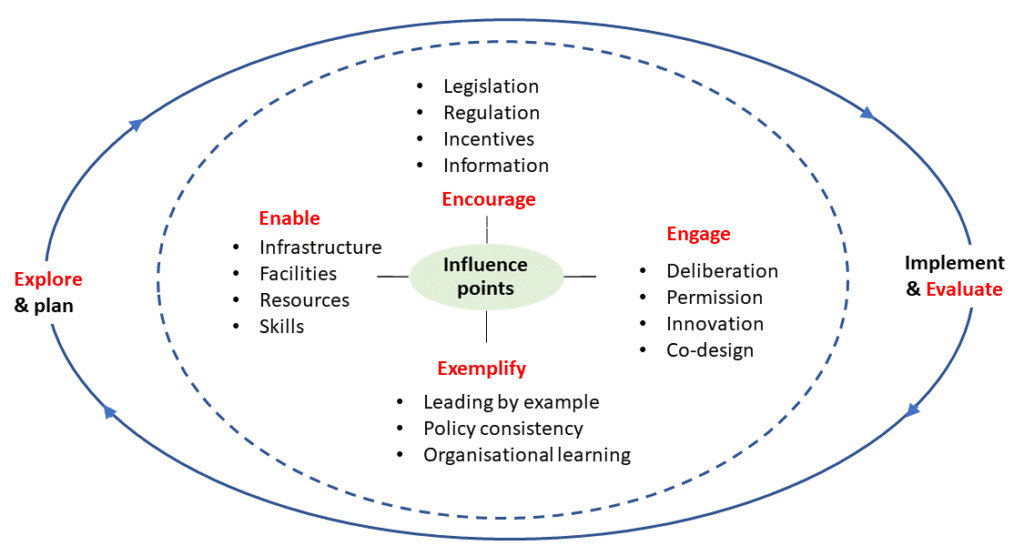Influencing practice change: An introduction to behaviour change models and strategies
Human behaviours, at a range of decision-making levels, play a key role in the many complex sustainability and development problems facing public sector policy staff. Challenges include issues such as climate change, public health, catchment (watershed) management, biodiversity and conservation management, income inequality and poverty. A deeper understanding of how people in their groups, communities and agencies make their decisions can help policy makers and others identify the underlying motivations and barriers for behaviour and behaviour change and consider these in your work. I was recently asked to present on the application of current behaviour change theory in practice, and this posting expands on this topic. The key message is that if we don’t understand some of the key determinants underlying behaviour – then it is hard to know what it takes to change it. The presentation is provided below as an inline version, along with a following summary of the content. The full reference to this workshop guide is appended at the bottom of this post along with a link to a downloadable PDF version for any of you that want.
The presentation introduces a few key models and theories to highlight the range of potential intervention points that could support constructive change initiatives. Then a framework is introduced as a prompt for agencies wanting to utilise a broader suite of approaches to more effectively encourage different groups and sectors to be mobilised, supported and encouraged to participate in the “common enterprise” of generating positive outcomes’. Finally the use of Theories of Change (ToC) are outlined as a way to support diverse stakeholders to work together and plan how to achieve desired outcomes.
In the past we have relied on three key approaches to bring about change: legislation and regulation; market forces and material incentives; and (largely one-way) communication and education programmes. However, recent research is highlighting that we need to move far beyond these largely one-way communication-based approaches to seeking practice changes. Our choices are not made solely on the basis of fully conscious, deliberate, or even rational processing of information. We are emotional; we are embedded in social and cultural networks; and are influenced by the context of decisions and the way choices are presented. As Toby Park and colleagues (2019) point out, building on these new behavioural insights remind us to focus on non-conscious as well as conscious drivers of behaviour; the need to focus on the setting of our behaviours as well as internal motives and drivers; and the need to focus on behaviours rather than solely beliefs, attitudes or intentions. Conventional legislation, incentives, messaging and education still have their place and may still be the most effective intervention in some situations. However, where that is not the case, or where implementation and enforcement is impossible, these broader systems-based behavioural approaches offer both an alternative and a new lens through which to evaluate the use of conventional tools.
Human behaviour itself is incredibly complex and a large number of theories and models have been developed to explain aspects of what shapes our decisions and behaviour. These have been developed over the past several decades from work in disciplines such as psychology, sociology, communication and political science looking at behavioural change. These can focus on the individual level, the interpersonal level, community and organizational levels or the enabling environment. None are perfect or tell the whole story, but collectively they can help us understand the underlying influences behind decision-making and behaviour.
Four behaviour change models
I highlight four well-known behaviour change models in the presentation to illustrate how the different models can help us identify different potential intervention points. The COM-B model of behaviour developed a decade ago by Susan Michie, Lou Atkins and Robert West is widely used to identify what needs to change in order for a behaviour change intervention to be effective. It identifies 3 factors that need to be present for any behaviour to occur – capability, opportunity and motivation. These three factors interact over time so behaviour can be seen as part of a dynamic system with positive and negative feedback loops. If we try a new behaviour and it works – then we gain confidence and skills that make the behaviour easier to do and maintain – and even improve. Kenneth Mcleroy and colleagues in the 1980s expanded on the socio-ecological model which emphasizes that health promotion should focus not only on the individual – but also on different social level groupings that influence the specific behavior in question. So, an individual can be seen to be influenced by family and friends at an interpersonal level, but also by the wider community or organization they are embedded in, and beyond that by public policy. Moreover, influence can occur in any direction among these levels. And fostering change at any of those levels with communication and engagement strategies still requires consideration of relevant capabilities, opportunity and motivation.
Another well-known approach to change is the Stages of Change or Transtheoretical Model, introduced in the late 1970s by researchers James Prochaska and Carlo DiClemente. In this model, change occurs gradually and relapses are an inevitable part of the process. People are often unwilling or resistant to change during the early stages, but they eventually develop a proactive and committed approach to changing a behavior. This model acknowledges that change is often not easy, and often requires a gradual progression of small steps toward a goal. And lastly Icek Azjen’s work in the mid 1980s on the Theory of Planned Behaviour points out a range of factors that influence our thoughts around programmes and technologies that ask us to change our practices. The model indicates that an individual’s intention to act is influenced by: i) how important they think the action is; ii) how easy or difficult the action is; and iii) the social pressure on them to do it.
The 6 E’s policy design framework
There are a range of policy choice tools that aim to link theory and practice, and in general these encourage policy makers to use a mix of options – taking the context and stakeholder characteristics into account. In a previous posting I looked at the UK Defra-developed 6Es policy framework as one such tool which provides a framework to help policy makers develop a mix of interventions across four broad categories of policy tools – Enable, Engage, Encourage and Exemplify (the inner circle). Two additional “E”s (see Figure 1 – outside circle), explore and evaluate, round out a process of informed policy design and results measurement. Using this tool as a checklist can help agencies to more effectively influence behaviour by combining approaches across these six broad categories.

Collectively, the approach and the mix of measures drawn from across the 6Es need to address the core motivations and barriers of the broader range of stakeholders involved – including agencies themselves. For example, it’s likely including measures that engage and enable will lead to “change” through those most willing and able to act. It’s also feasible that some other groups may act if agencies demonstrate their own willingness to “walk the talk” and model the collaborative behaviours they would like to encourage. For others there is a role for regulation, or the development of minimum or voluntary standards before behaviour is influenced.
Theories of Change
The final presentation section looks at Theory of Change as a tool to set out, and communicate complex goals and intended outcomes, as well as the underlying activity strategies that include not only technical and operational workstreams – but also our social (communication, education and engagement) initiatives. The strength of a Theory of Change approach is that it invites us to clarify what outcomes and change that we want from different groups of people (individuals, communities, organizations, etc.) – and then to use our knowledge of past experience and behaviour models to plan pathways that really lead to change.
The approach here recognises the need for participation in these endeavours to influence practice change. All too many of our current societal challenges —such as the environment, health care, and poverty—are complex, whether on a local, national, or international scale. Yet all too often we approach these issues with linear and even siloed solutions that aren’t sufficient to address the problems at the scale at which they exist. Successful outcomes from addressing these ‘wicked problems’ increasingly depend on the coordinated actions of decision-makers at different levels. This is where cross-sector partnerships and collaborations come into play. By sharing information, resources, activities, and capabilities we can achieve desired outcomes by working together that we could never achieve alone.
[Reference as: Will Allen(2021) Influencing practice change: An introduction to behaviour change models and strategies (Presentation). Available online https://learningforsustainability.net/pubs/practicechange-intro.pdf]
An independent systems scientist, action research practitioner and evaluator, with 30 years of experience in sustainable development and natural resource management. He is particularly interested in the development of planning, monitoring and evaluation tools that are outcome focused, and contribute towards efforts that foster social learning, sustainable development and adaptive management.

Leave a Reply